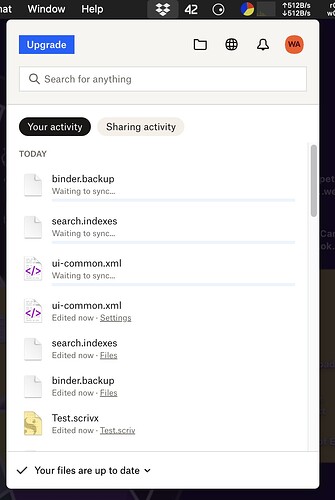It’s not the touch ID that’s causing it. I suspect it’s Dropbox, and I suspect the problem I reported here is a DB-generated one as well.
To attempt to replicate the difficulty I’ve been having, I created a new project on my Mac and banged out a couple sentences in it. Then I saved the project and closed it, opened the Dropbox menu icon, and saw this:
As you can see, there are a couple files at the top that are “waiting to sync.” As you can also see, the Dropbox icon is lacking the sync flag (circle with arrows in it). So one part of DB is waiting for content to sync, while another part of DB apparently has no idea there’s content that needs to be synced.
I kept the window open to see what would happen. Those items did eventually sync, but after a four-minute delay.
As far as I’m concerned, that makes it glaringly clear touch ID on the iPad app has nothing to do with it, as it hadn’t even seen the file yet.
The Dropbox app for macOS, version 209.4.3661, shows a last modification date of Oct. 4. This was likely when it was most recently updated (DB updates silently). And I first started noticing this problem in early October. I don’t believe in that level of coincidence.
Pretty sure their latest update borked something somewhere, and until and unless they address this, we’re going to continue seeing it. And as Dropbox will not allow you to submit a bug report or support request unless you have a paid subscription (no way am I coughing up $10 a month just to do them a favor by reporting an error in their code), it might be a while before they pull up their socks and address it.
We’re so close to having an alternative, though, as I’m able to import existing .scriv projects from my iCloud drive into Scrivener for iPad. Unfortunately the only two choices are to store it “on my iPad” or in Dropbox, according to the dialog that opens; and once it’s in there (“on my iPad”), changes I make are not reflected in the project in the iCloud folder. This presumably is what “import” means, heh.
It would be so very nice if I weren’t relegated to those two choices, if I could instead have Scrivener for iPad treat external .scriv files in a way similar to what the desktop app offers — opening the file opens the app, editing happens, it’s saved without needing to import or export, etc. — though I imagine the coding might be fraught, as iOS in general really isn’t designed to work that way.
The other option would be to allow user-selected folders for syncing, thus relying exclusively on iCloud to make it happen, if users wanted that option, and bypassing Dropbox entirely. But that’s yet another fraught exercise, I suspect.
